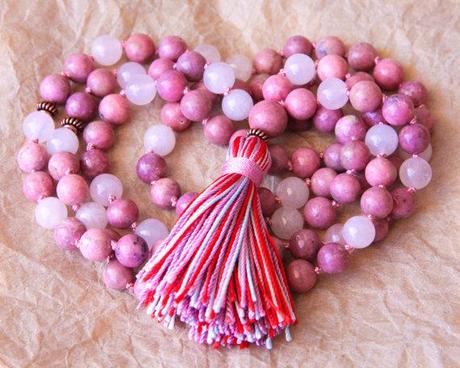
A mala is a strand of beads, traditionally used for counting during mantra meditations. Malas can consist of 108 beads, 54 beads, 27 beads, 21 or 19 beads. Malas have been used since at least the 10th century as a meditation aid. They allow us to focus the mind on a single pointed task as we work through our meditation. If you practice meditation and yoga, a mala can be a powerful tool in your quest for wellness and clearer understanding.
Using a Mala
Using a mala is easy. Begin at the summit or guru of the mala, the larger bead at its base. Drape the first mala bead, the one adjacent to the guru on your right, in between your thumb and middle finger. Use your thumb to slide the first mala bead down and move to the next bead. Repeat this movement for a count of 108, 54, 27, 21 or 19 beads. During this process you may choose to focus on your breathing, moving past each mala bead as you take an in breath or an out breath. As you do so the mala acts an object that aids in a single pointed focus on your breath. In other meditations, you may wish to focus on something that you wish for in yourself or something you wish to understand about yourself. For example, if you are working through an emotion in your life, such as forgiveness, you may want to use your mala during a meditation for forgiveness. As you pass over each mala bead you may want to imagine radiant loving energy passing through your body and then flowing to the person or situation you need to forgive. If you repeat this 108 times over one meditation, several weeks of meditation, or longer you will notice a shift in your consciousness and energy state.
Choosing a Mala
Selecting the right mala for your practice can be a challenging task given the wide variety of products on the market. Some malas are made in traditional materials such as rudraksha seed, bodhi seed, or yak bone. These materials are typically less expensive and an affordable option. Other malas are made from gemstones. Gemstone malas have several advantages from a physical and spiritual perspective. The mala beads are typically heavier and smoother. The weight becomes an advantage as you hold your mala between you thumb and middle finger because gravity helps hold the mala in place. Gemstones are also smooth and can glide with more ease. Finally, gemstones have meanings which can help you choose an emotional or spiritual aspect that you want to work on through meditation, and your mala can become a focused object that you carry with you to help you in your spiritual journey.
For example, with spring around the corner you may want to work on a mental and spiritual spring cleaning. This may include focusing on detoxification and purification from the winter. One gemstone that can help with this is amethyst. Amethyst is excellent for protection and purification. It is believed to aid in curbing overindulgence and it can help us give up bad habits. It is a stone for clearing negative influences, and can bring light, inner space to one’s body, and it can help balance to your energy field. Using a mala made from amethyst beads in conjunction with meditations for addictions, renewal of the energy body, or release of negativity can be a powerful combination during springtime. Many mala makers offer custom design services. As you decide on an emotional or spiritual area you would like to work on through meditation, you can commission a mala designer to select the perfect gemstones and guru for your practice.
Many people choose to use their mala in contexts outside of seated meditation. Wearing a mala as a bracelet or necklace is common. This helps keep your affirmations or intentions with you throughout the day. People may choose to carry their mala in a mala bag that is kept in a pocket or purse as another way of keeping their practice with them as they move through their lives. Having your mala with you at all times means that you can use it while in waiting rooms, while in transit, while in lines or while taking a break. Other people keep their mala in their meditation shrine when it is not in use. A mala can become a beautiful feature of your sacred space, adding color, texture, and intention to your shrine. Finally, some people take their mala to yoga practice and coil it at the top of their yoga mats or wear it during the practice. They believe this helps the mala absorb the energy of their physical practice and helps them carry their yoga practice with them when off the mat. Whichever way you choose to use your mala, mala beads can be a representative object of your intentions or affirmations and are powerful for helping focus the mind on that which you most hope to develop through your yoga and meditation practice.
Sources
Richard Simmons, 2011, The Book of Stones: Who They Are and What They Mean, North Atlantic Books: Berkeley
